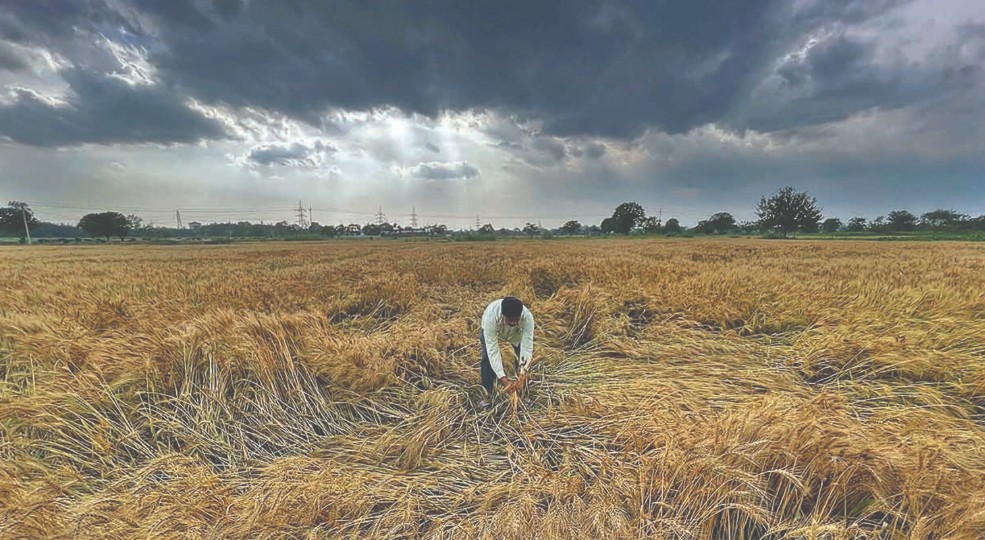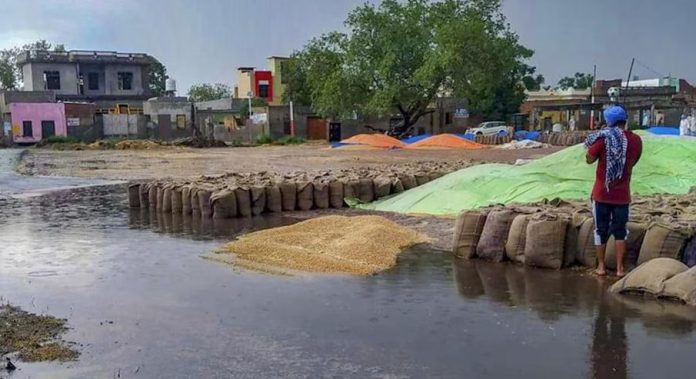Overnight rains have wreaked havoc on the wheat grains stored in various mandis (grain markets) across Punjab, causing significant concerns among farmers, commission agents, and procurement agencies alike. The unseasonal downpour, which lashed many parts of the state, led to waterlogging in the open-air mandis where harvested wheat was awaiting purchase and lifting. This unfortunate event has raised serious questions about the preparedness of the authorities to handle unexpected weather conditions and the potential for substantial financial losses for the agricultural community.
The state of Punjab, often referred to as the “food bowl of India,” is currently in the peak of its wheat procurement season. Farmers, having toiled for months to cultivate and harvest their crops, bring their produce to the mandis to sell to government agencies and private traders. These mandis, often bustling hubs of activity, become temporary storage spaces for vast quantities of wheat, typically kept in jute bags stacked in the open due to the sheer volume of the harvest and the sometimes-delayed lifting process.
The overnight rains proved to be particularly damaging as they caught many unprepared. While some commission agents and farmers reportedly made arrangements like tarpaulins and wooden racks to mitigate potential weather damage, the intensity and unexpected nature of the rainfall overwhelmed these measures in many locations. Reports from various districts painted a grim picture of soaked gunny bags filled with wheat, and in some mandis, grains were seen floating in muddy rainwater.
The immediate concern arising from this situation is the deterioration of the quality of the wheat grains. Once soaked, the grains are susceptible to increased moisture content, which can lead to fungal growth, discoloration, and a reduction in their overall quality. This can have severe implications for the farmers, who may face rejection of their produce by procurement agencies or be forced to sell at significantly lower prices. The commission agents, who act as intermediaries between the farmers and the buyers, also stand to suffer losses as the value of the damaged wheat diminishes.

Adding to the woes is the already existing issue of delayed lifting of the procured wheat from the mandis. Farmers and commission agents have been voicing their concerns about the slow pace of transportation and the resulting accumulation of stocks in the open. The overnight rains have now compounded this problem, as the soaked grains will require time and effort to dry properly before they can be safely stored in godowns. This delay in lifting not only exposes the grains to further potential damage from subsequent weather events but also clogs up space in the mandis, hindering the arrival and storage of fresh produce.
The agricultural community is understandably upset and worried about the potential financial repercussions of this damage. They are urging the state government and procurement agencies to expedite the lifting process and to implement emergency measures to protect the remaining stocks from further spoilage. There are also growing demands for compensation for the losses incurred due to the rain damage. Farmers and their representatives argue that the authorities, including the market committees and local administrations, should have had better contingency plans in place to deal with unseasonal weather, such as adequate tarpaulin covers and efficient drainage systems in the mandis.
The state government is likely to face increasing pressure to assess the extent of the damage and to announce relief measures for the affected farmers and commission agents. This could involve conducting surveys (girdawari) to ascertain the losses and providing financial assistance or compensation to those who have suffered significant damage to their wheat stocks. The government will also need to address the systemic issues that contributed to this situation, such as the delays in lifting and the inadequacy of infrastructure in some mandis to protect against weather-related risks.
The India Meteorological Department (IMD) had reportedly issued forecasts that included the possibility of thundershowers in the region. This raises questions about whether sufficient precautionary measures were taken by the concerned authorities in anticipation of adverse weather. An assessment of the communication channels and the responsiveness of the administrative machinery to weather warnings will be crucial in preventing similar incidents in the future.
The incident serves as a stark reminder of the vulnerability of the agricultural sector to the vagaries of weather, especially in the context of changing climate patterns. It also underscores the importance of robust infrastructure and efficient management systems in the agricultural supply chain to minimize losses due to unforeseen events. The focus will now be on how effectively the state government and procurement agencies respond to this crisis and what steps will be taken to mitigate the impact on the farmers and to prevent such damage from recurring in the future. The agricultural community in Punjab, already facing various challenges, will be keenly observing the response of the authorities in this critical situation.


